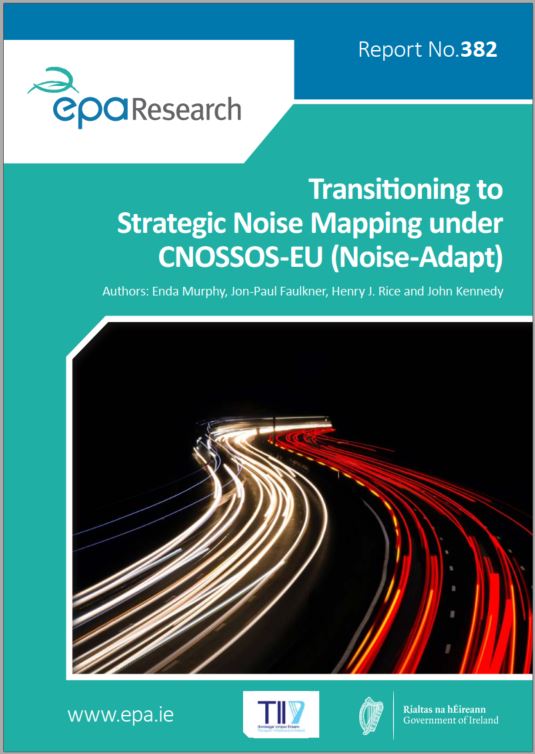Authors: Enda Murphy, Jon-Paul Faulkner, Henry J. Rice and John Kennedy
Summary: In the European Union (EU), 113 million people are estimated to be exposed to noise pollution from transport sources and this is detrimental to their health and quality of life. This report addresses noise pollution from transport as a significant environmental pressure and public health concern by providing recommendations that assist with the practical implementation of revisions to the Environmental Noise Directive.

Watch the project highlights video
In the European Union (EU), 113 million people are estimated to be exposed to noise pollution from transport sources and this is detrimental to their health and quality of life. Internationally, there is a growing evidence base that links noise from transport sources to health issues, including sleep disturbance, annoyance, heart disease, cognitive impairment, quality of life and mental health and wellbeing. This report addresses noise pollution from transport as a significant environmental pressure and public health concern by providing guidance that assists with the practical implementation of revisions to the Environmental Noise Directive (END; 2002/49/EC). Given that Ireland has a statutory obligation to meet the requirements of the END, this is a strategic national environmental priority. This document outlines research conducted to assist with the objective of implementing regulations set out in the END and, in doing so, assists with developing future national capacity that contributes towards meeting Ireland's legislative obligations under EU law.
Internationally, this report contributes to improving the implementation of the END which utilises the CNOSSOS-EU (Common Noise Assessment Methods in Europe) methodology from 2019 onwards. Outputs from this report have the potential to inform EU and national guidance on the implementation of the END under CNOSSOS-EU. Nationally, the report contributes to policy by providing practical guidance for transitioning to the new CNOSSOS-EU noise modelling and mapping methodology, which may assist with the development of future Environmental Protection Agency guidance in this area. Furthermore, it has the potential to contribute to a range of national policy areas, creating a positive feedback loop between policies for transport, land use/spatial planning and environmental health. The report also aligns with identified national research priorities, namely improving the health of the population and building a safe and sustainable environment.
The development of strong guidance for implementing environmental legislation has the potential to assist with transitioning to more sustainable environmental practices, which can benefit the health and wellbeing of the wider population. The current shift towards the CNOSSOS-EU methodology for strategic noise mapping provides Irish and EU authorities with the opportunity for a “reset moment” with respect to implementation of the END. This report aims to assist authorities in developing strong evidence-based advice on how to implement CNOSSOS-EU. The report provides wide-ranging adaptation guidance for relevant stakeholders. In doing so, the report (1) provides a data needs/gaps assessment for adapting to CNOSSOS-EU for road and rail sources in Ireland; (2) evaluates the CNOSSOS-EU methodology to assess its suitability and shortcomings; (3) identifies an approach for implementing the CNOSSOS-EU methodology for estimating population exposure; (4) reassesses past Irish strategic noise mapping data and population exposure estimates using the CNOSSOS-EU methodology; (5) evaluates the current approach for assessment of industrial noise; and (6) provides key recommendations for future noise mapping rounds under CNOSSOS-EU.
Research 383: Towards a Good Practice Guide for Implementing CNOSSOS-EU in Ireland
https://www.epa.ie/media/epa-2020/research/epa-funded-research/Report_Cover_382.jpg